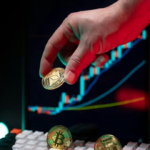
The digital asset market, particularly cryptocurrencies, has matured from its early speculative days into a complex ecosystem. As global macroeconomic factors like inflation, interest rates, and geopolitical events increasingly influence asset prices, the behavior of cryptocurrencies reveals unique correlations and decouplings from traditional financial markets. This blog will delve into how these forces shape digital asset prices and the patterns of divergence between the crypto and conventional finance sectors.
Inflation and Its Impact on Digital Asset Prices
Inflation has long been a significant force in traditional markets, affecting the value of currencies, commodities, and even stocks. However, in the digital asset space, inflation has a dual effect. On the one hand, rising inflation can devalue fiat currencies, making decentralized digital assets like Bitcoin an attractive alternative for investors seeking to preserve value. Cryptocurrencies, particularly Bitcoin, have often been described as digital gold due to their limited supply, which contrasts with the ability of governments to print more money.
On the other hand, inflationary pressures can also reduce the disposable income of retail investors, leading to reduced participation in speculative markets, including cryptocurrencies. This dynamic creates a mixed correlation where digital assets sometimes rise in response to inflation fears but may decouple when consumer confidence dips.
Interest Rates and the Cost of Capital
Interest rates, controlled by central banks worldwide, are a critical lever for global economies, impacting borrowing costs and investment flows. In traditional markets, rising interest rates often signal reduced liquidity as borrowing becomes more expensive. For digital assets, this creates a ripple effect. Higher interest rates can decrease the appeal of high-risk assets like cryptocurrencies as investors shift to safer, yield-generating assets like bonds or savings accounts.
In contrast, during periods of low interest rates, speculative investments in digital assets typically surge, driven by the search for higher returns. This correlation highlights how the crypto market can act as a risk-on, risk-off asset class, with its fortunes closely tied to macroeconomic trends. However, during times of extreme liquidity in traditional finance, digital assets may decouple, rallying independently as investors seek alternatives to fiat-based returns.
Geopolitical Events: Crypto’s Safe Haven Status
Geopolitical tensions, such as trade wars, conflicts, and political instability, historically have led investors to seek safe-haven assets like gold or stable currencies. In recent years, digital assets have begun to share this status. For example, during the Russian-Ukrainian conflict and in regions experiencing political unrest, we witnessed a significant increase in demand for cryptocurrencies. Bitcoin and stablecoins like USDC have been viewed as a refuge from collapsing local currencies and stringent capital controls.
However, the reaction of digital assets to geopolitical events is not always uniform. While some events boost demand for digital assets, others may cause decoupling, particularly when governments impose regulations or crackdowns on cryptocurrency usage. Such incidents illustrate how geopolitics can create both correlations and decouplings, with digital assets serving as both an alternative and, at times, a vulnerable asset class.
Unique Correlations and Decouplings
Despite the growing influence of macroeconomic factors, digital assets often exhibit a fascinating tendency to decouple from traditional markets. This decoupling becomes evident during periods of extreme volatility. For instance, while global equities may plummet due to market fears, certain cryptocurrencies, driven by their decentralized nature and differing market participants, might react in the opposite direction or remain unaffected. This decoupling underscores the independence of the digital asset market, though it remains connected to broader financial trends.
As cryptocurrencies continue to mature, the digital asset market will likely experience more correlations with traditional finance while retaining its unique decoupling characteristics. This balance of independence and interdependence shapes the market, offering opportunities and challenges for both retail and institutional investors alike.
Embrace the New Era of Digital Asset Management
Join Kenson Investments and explore innovations in the blockchain and digital assets sector. Our digital asset specialists are here to help you navigate the complexities of digital asset portfolios and defi services.
Call now to discover how we’re moving the industry forward!
Disclaimer: The information provided on this page is for educational and informational purposes only and should not be construed as financial advice. Cryptocurrency assets involve inherent risks, and past performance is not indicative of future results. Always conduct thorough research and consult with a qualified financial advisor before making investment decisions.
“The cryptocurrency and digital asset space is an emerging asset class that has not yet been regulated by the SEC and US Federal Government. None of the information provided by Kenson LLC should be considered financial investment advice. Please consult your Registered Financial Advisor for guidance. Kenson LLC does not offer any products regulated by the SEC, including equities, registered securities, ETFs, stocks, bonds, or equivalents.”














